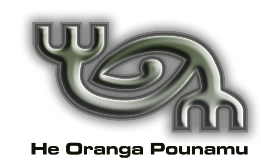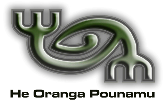
June 2009
Christchurch Transport Interchange: Health
Impact Assessment 2007/08 – 2008/09
Hui Facilitation and Māori Work Stream Report
Writing
Report prepared for Canterbury DHB
Author Angelia Ria
1.
HE ORANGA POUNAMU CHARITABLE TRUST
MANA WHAKATIPU ō tātou – Our Mandate & Purpose
He Oranga Pounamu Charitable Trust is a Māori Development Organisation established in June
2000, under mandate from Te Runanga o Ngāi Tahu, the result of extensive consultation with
the NGO provider sector, Māori communities and Ngāi Tahu whanui. He Oranga Pounamu
provides leadership in service development within the Ngāi Tahu rohe with an aim to improve
health and social outcomes for all Māori within the rohe. Our moemoea (vision) is He Hauora
Māori ki te rohe o Ngāi Tahu, “Healthy Māori in the Ngāi Tahu rohe”.
2.
THE CHRISTCHURCH TRANSPORT INTERCHANGE PROJECT
He Oranga Pounamu is pleased to have been involved in the Christchurch Transport
Interchange Health Impact Assessment Steering Group, contributing to such an important
development for our district. In addition to the provision of resources to support the group, He
Oranga Pounamu facilitated dialogue with Māori about the health impact of the proposed
Transport Interchange through community hui to inform the public consultation process.
3.
CANTERBURY MĀORI COMMUNITY CONSULTATION HUI
He Oranga Pounamu facilitates monthly Māori Community Consultation Hui in Christchurch and
quarterly Hui in Timaru. The Hui are advertised through our networks however we encourage
dissemination of panui (notices) through those networks to any interested party. The purpose
of the Hui is to provide a platform for government agencies, researchers and service provider’s
interalia to access Māori, introduce initiatives and seek feedback in a two-way communication
process. The Hui also provides an opportunity for people to network and share information.
Our stakeholders include representatives of government and non-government organizations
working in health and social services, education, justice, housing, and employment and
members of Māori communities (the public), including koroua and kuia (respected elders), who
have an interest in Māori well being. Between 50 - 70 people attend the meetings each
month.
2 | P a g e
The Christchurch Transport Interchange Project was presented at the Canterbury Māori
Community Consultation Hui on the following dates.
Canterbury MCC Hui
Presenter(s)
Objective
14 May 2008
Fiona Pimm, He Oranga
Brainstorm Health Impact of
Pounamu
Transport Interchange
15 April 2009
Ben Mitchell, Anna Stevenson,
Project Presentation
Community Public Health,
Recommendations from the
Siobhan Storey, Christchurch
Health Impact Assessment
City Council Angelia Ria, He
Report
Oranga Pounamu
Verbal feedback from
participants
It is pertinent to note that participation and feedback gained from Hui participants about the
Transport Interchange Project and Health Impact Assessment represents a sample of Māori
opinion and should not be considered a consultation with Māori resident in Waitaha
(Canterbury) or the view of Te Runanga o Ngāi Tahu.
3.
HEALTH IMPACT ASSESSMENT
Feedback is grouped under accessibility, social connectedness and access to services, active
transport and physical activity. In particular, safety for commuters was a strong theme.
Participants commented that the current bus exchange feels unsafe, due to the layout and poor
lighting and that pedestrian safety should be ensured by high quality pedestrian crossings
feeding the transport interchange. Social connectedness was not just about providing a
physical space to encourage interaction but also actively encouraging the involvement of
community organisations in the transport interchange.
a.
Accessibility
Bus fares (pricing schemes) must be kept at a reasonable rate (balanced with rate payers
getting value for money) to ensure accessibility as well as promote social connectedness.
Designers must incorporate ease, safety and choice including multiple entrances and exits for
passengers when moving to, through and from the interchange with particular regard for those
with disabilities (physical, sight impaired, hearing impaired), kāumatua (older people), māmā
and pēpe (mother and babies) and tamariki (children). Disability appropriate escalators and
elevators (Braille signage and audio) and covered platforms to protect people from the
elements were also mentioned.
3 | P a g e
The interchange should be smoke free, kept clean and have air conditioning / central heating,
good lighting, public amenities including toilets with disability access, parent rooms for
breastfeeding, nappy changing etc, rest areas, free water, and a sickbay (St John’s Ambulance).
Helping people move around the interchange and understand how it works was viewed as
pivotal through the provision of Information Desks and mobile staff, legible signage, translation
services and large screens for viewing arrivals and departures.
Safety was considered paramount as people should be free to encounter each other without
hindrance. Suggestions for security included surveillance cameras as well as the utilisation of
community organisations such as the Māori Wardens to provide general security patrolling.
b.
Social Connectedness and Access to Services
The Transport Interchange should be respectful of Canterbury (Waitaha) heritage as well as
support contemporary culture. Māori contribution to the space includes indigenous design,
native plants and most importantly – a water feature to promote spiritual wellbeing. Seating
and the arrangement thereof was considered important to encourage communication and
interaction but also social distance to provide for those who preferred to rest and/or read.
The Transport Interchange should be designed as a hub to include services that commuters
could make use of during their transfers such as food outlets, convenience stores. A medical
centre was suggested for people who may have transport issues with regard to their own
general practitioners. The space should also stimulate public activity with areas to showcase,
buskers, other artists but also include separate quite areas for resting.
c.
Active Transport and Physical Activity
The transport interchange should reflect health promotion - "the process of enabling
individuals and communities to increase control over the determinants of health and thereby
improve their health” through the promotion of walking and cycling. A number of high quality
pedestrian crossings around the transport interchange would encourage pedestrian flow as well
as promote safe crossing. Secure bike stands with covers and lockers would encourage cycling.
It was also suggested that the transport interchange include car parking to encourage the use of
other means of transport out of the Central Business District including cycles, buses and trams.
4.
CONSULTATION WITH RANGATAHI (YOUNG PEOPLE)
Participants were fervent that rangatahi (young people) are a significant interest group
(majority of current users and future users) and must be consulted in the on-going process.
4 | P a g e
5.
APPENDIX
A.
Canterbury Māori Community Consultation Hui Agenda 14 May 2008
B.
Canterbury Māori Community Consultation Hui Agenda 15 April 2009

A.
Canterbury Māori Community Consultation Hui
Living with Cancer
Wednesday 14 May 2008
Room 1, Mancan House, corner Cambridge Terrace and Manchester Street, Christchurch
Agenda
9.00 am
Karakia / Mihi, Fiona Pimm
9.05 am
CDHB Oncology Maori Health Worker - Theo Ireton
and Ngā Ratonga Hauora Maori
9.35 am
Cancer Society – Liz Horn
10.05 am
Prostate Cancer Foundation – Chris Jones
10.35 am
Nurse Maude – Sally Pitama
11.05 am
Arthritis New Zealand – “Living a Healthy Life”
Kathy Simmons
11.35 am
CanTeen – Young People Living with Cancer
Matt Truman and Koral Fitzgerald
12.05 pm
Canterbury DHB Maori and Pacific Scholarship Fund
12.15 pm
Christchurch City Council Bus Exchange Consultation –
Health Impact Assessment
1.00 pm
Lunch / Whanaungatanga
6 | P a g e

B.
Canterbury Māori Community Consultation Hui
Wednesday 15 April 2009
Room 1& 2, MANCAN House, corner Cambridge Terrace and Manchester Street,
Christchurch
Agenda
9.00 am
Karakia / Mihi
9.05 am
Dr Ted Arnold, Gill Prior & Aroha Reriti-Crofts
Seeking Help for Continence
10.30 am
Morning Tea
10.45 am
Coronial Services Unit - Sue Johnson, Regional Coroner
The Role of the Coroner
11.30 am
Christchurch City Council – Ben Mitchell, Anna Stevenson
& Siobhan Storey
Christchurch Transport Interchange Project
12.00 am
Community and Public Health, (CDHB) Heather Kimber and Olivia Papuni
Smokefree Playgrounds and Parks and Consultation for Smokefree Public Places
Policy
1.00 pm
Lunch
7 | P a g e


